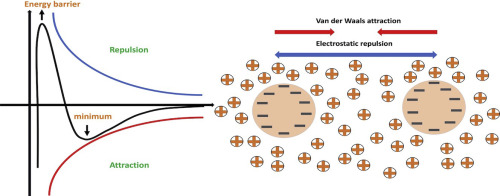当前位置:
X-MOL 学术
›
Adv. Colloid Interface Sci.
›
论文详情
Our official English website, www.x-mol.net, welcomes your
feedback! (Note: you will need to create a separate account there.)
Nanoparticle processing: Understanding and controlling aggregation.
Advances in Colloid and Interface Science ( IF 15.9 ) Pub Date : 2020-04-16 , DOI: 10.1016/j.cis.2020.102162 Sweta Shrestha 1 , Bo Wang 1 , Prabir Dutta 2
Advances in Colloid and Interface Science ( IF 15.9 ) Pub Date : 2020-04-16 , DOI: 10.1016/j.cis.2020.102162 Sweta Shrestha 1 , Bo Wang 1 , Prabir Dutta 2
Affiliation

|
Nanoparticles (NPs) are commonly defined as particles with size <100 nm and are currently of considerable technological and academic interest, since they are often the starting materials for nanotechnology. Novel properties develop as a bulk material is reduced to nanodimensions and is reflected in new chemistry, physics and biology. With reduction in size, a greater function of the atoms is at the surface, and promote different interaction with its environment, as compared to the bulk material. In addition, the reduction in size alters the electronic structure of the material, resulting in novel quantum effects. Size also influences mobility, primarily controlled by Brownian motion for NPs, and relevant in biological and environmental processes. However, the small size also leads to high surface energy, and NPs tend to aggregate, thereby lowering the surface energy. In all applications, the uncontrolled aggregation of NPs can have negative effects and needs to be avoided. There are however examples of controlled aggregation of NPs which give rise to novel effects. This review article is focused on the NP features that influences aggregation. Common strategies for synthesis of NPs from the gas and liquid phases are discussed with emphasis on aggregation during and after synthesis. The theory involving Van der Waals attractive force and electrical repulsive force as the controlling features of the stability of NPs is discussed, followed by examples of how repulsive and attractive forces can be manipulated experimentally to control NP aggregation. In some applications, NPs prepared by liquid methods need to be isolated for further applications. The process of solvent removal introduces new forces such as capillary forces that promote aggregation, in many cases, irreversibly. Strategies for controlling aggregation upon drying are discussed. There are also many methods for redispersing aggregated NPs, which involve mechanical forces, as well as manipulating capillary forces and surface characteristics. We conclude this review with a discussion of aggregation relevant real-world applications of NPs. This review should be relevant for scientists and technologists interested in NPs, since emphasis has been on the practical aspects of NP-based technology, and especially, strategies relevant to controlling NP aggregation.
中文翻译:

纳米颗粒加工:了解和控制聚集。
纳米粒子(NPs)通常定义为尺寸小于100 nm的粒子,由于它们通常是纳米技术的起始材料,因此目前在技术和学术上都引起了广泛的关注。随着将大块材料还原为纳米尺寸,新特性得以发展,并反映在新的化学,物理学和生物学中。与本体材料相比,随着尺寸的减小,原子在表面上具有更大的功能,并促进了与其环境的不同相互作用。另外,尺寸的减小改变了材料的电子结构,从而产生了新颖的量子效应。大小也会影响迁移率,主要受NP的布朗运动控制,并且与生物学和环境过程有关。但是,小尺寸也会导致较高的表面能,并且NP倾向于聚集,从而降低表面能。在所有应用中,NP不受控制的聚集都会产生负面影响,需要避免。然而,存在NP的受控聚集的实例,其引起新颖的效果。本文将重点介绍影响聚合的NP功能。讨论了从气相和液相合成NP的常见策略,重点是合成期间和合成后的聚集。讨论了涉及范德华力和电排斥力作为NP稳定性控制特征的理论,然后举例说明如何通过实验操作排斥力和吸引力来控制NP聚集。在某些应用中,通过液体方法制备的NP需要分离以用于进一步的应用。在许多情况下,去除溶剂的过程会引入新的力,例如毛细作用力,从而不可逆地促进聚集。讨论了控制干燥时聚集的策略。还有许多重新分散聚集的NP的方法,这些方法涉及机械力以及操纵毛细作用力和表面特性。在总结本综述时,我们讨论了与NP相关的现实世界中的聚合应用。由于对基于NP的技术的实际方面(尤其是与控制NP聚集相关的策略)的重视一直在进行,因此该评论应该与对NP感兴趣的科学家和技术人员有关。还有许多重新分散聚集的NP的方法,这些方法涉及机械力以及操纵毛细作用力和表面特性。在总结本综述时,我们讨论了与NP相关的现实世界中的聚合应用。由于对基于NP的技术的实际方面(尤其是与控制NP聚集相关的策略)的重视一直在进行,因此该评论应该与对NP感兴趣的科学家和技术人员有关。还有许多重新分散聚集的NP的方法,这些方法涉及机械力以及操纵毛细作用力和表面特性。在总结本综述时,我们讨论了与NP相关的现实世界中的聚合应用。由于对基于NP的技术的实际方面(尤其是与控制NP聚集相关的策略)的重视一直在进行,因此该评论应该与对NP感兴趣的科学家和技术人员有关。
更新日期:2020-04-16
中文翻译:

纳米颗粒加工:了解和控制聚集。
纳米粒子(NPs)通常定义为尺寸小于100 nm的粒子,由于它们通常是纳米技术的起始材料,因此目前在技术和学术上都引起了广泛的关注。随着将大块材料还原为纳米尺寸,新特性得以发展,并反映在新的化学,物理学和生物学中。与本体材料相比,随着尺寸的减小,原子在表面上具有更大的功能,并促进了与其环境的不同相互作用。另外,尺寸的减小改变了材料的电子结构,从而产生了新颖的量子效应。大小也会影响迁移率,主要受NP的布朗运动控制,并且与生物学和环境过程有关。但是,小尺寸也会导致较高的表面能,并且NP倾向于聚集,从而降低表面能。在所有应用中,NP不受控制的聚集都会产生负面影响,需要避免。然而,存在NP的受控聚集的实例,其引起新颖的效果。本文将重点介绍影响聚合的NP功能。讨论了从气相和液相合成NP的常见策略,重点是合成期间和合成后的聚集。讨论了涉及范德华力和电排斥力作为NP稳定性控制特征的理论,然后举例说明如何通过实验操作排斥力和吸引力来控制NP聚集。在某些应用中,通过液体方法制备的NP需要分离以用于进一步的应用。在许多情况下,去除溶剂的过程会引入新的力,例如毛细作用力,从而不可逆地促进聚集。讨论了控制干燥时聚集的策略。还有许多重新分散聚集的NP的方法,这些方法涉及机械力以及操纵毛细作用力和表面特性。在总结本综述时,我们讨论了与NP相关的现实世界中的聚合应用。由于对基于NP的技术的实际方面(尤其是与控制NP聚集相关的策略)的重视一直在进行,因此该评论应该与对NP感兴趣的科学家和技术人员有关。还有许多重新分散聚集的NP的方法,这些方法涉及机械力以及操纵毛细作用力和表面特性。在总结本综述时,我们讨论了与NP相关的现实世界中的聚合应用。由于对基于NP的技术的实际方面(尤其是与控制NP聚集相关的策略)的重视一直在进行,因此该评论应该与对NP感兴趣的科学家和技术人员有关。还有许多重新分散聚集的NP的方法,这些方法涉及机械力以及操纵毛细作用力和表面特性。在总结本综述时,我们讨论了与NP相关的现实世界中的聚合应用。由于对基于NP的技术的实际方面(尤其是与控制NP聚集相关的策略)的重视一直在进行,因此该评论应该与对NP感兴趣的科学家和技术人员有关。











































 京公网安备 11010802027423号
京公网安备 11010802027423号